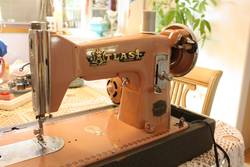

Head: This part is basically made up of the whole sewing machine without the carrying case and the cabinet.ġ1. Feed Dogs: The feed Dog is made up of teeth placed beneath the needle plate.This is the part that ensures the cloth moves forward as you sew.ġ0. Some of the parts that can also be oiled includes take-up lever and the bar plate.ĩ. Face Plate: This the part that makes it easy to oil the different parts of the needle bar that require oiling. ?By looping the needle thread and the bobbin thread together it forms a stitch.Ĩ. Bobbin: This is the part that holds the thread. Bobbin Winder: Bobbin winder’s main function in a sewing machine is to ensure that the bobbin gets controlled.While winding the bobbin the speed should be medium otherwise it can stretch and break.ħ. Bobbin Cover: The main function of this part is to cover the bobbin case and the Bobbin in your sewing machine.Ħ.

The bobbin case wraps the bobbin thread when the thread is pulled around.ĥ. It provides tension for the lower thread and holds the bobbin. Bobbin Case: This is the place where the bobbin stays. The main function of the bed is to stabilize the sewing machine.Ĥ. On top of the feed dog there is also a lower thread and shuttle. This is normally the flat part of the sewing machine. Bed: The bed is mounted on the feed dog found below it. This wheel is on the right side of the machine.ģ. It is driven by the motor but in some cases may be turned using hands to adjust the height of the needle. Its function is to lower and raise the needle. Hand wheel/Balance Wheel: This is the part that sets motion mechanisms. It is normally the curved part of the head.Ģ. Arm: This part contains mechanisms for operating the sewing needle. The lower part of a sewing machine contains legs, Treadle, Dress guard, Belt Guide, Band wheel, Belt Shifter, Pitman rod and Band wheel crank. The upper part of a sewing machine has Bed, Arm and Head. Sewing machines can be divided into two main parts. Sewing machines are designed to join different pieces of leather and fabrics through different means such as chain stitch or lockstitch. Garments manufacturing industry highly depends on sewing machines.
ATLAS SEWING MACHINE PARTS MANUAL
Most of the sewing machine come along with their manual from the manufacturer unfortunately it takes time to learn word by word and the way of its operations. Mechanically it is very needful to understand composition of the machinery during operation and repair. It is always essential to know the basic parts of a sewing machine because by so doing you will be able to use your sewing machine in the best way possible especially during your initial stages of understanding what is composed of in terms of parts. Regardless of the manufacturer of your sewing machine, most sewing machines come with the same parts. Some sewing machines have open systems where there is an option of adding more mechanical or electronic parts to boost the functioning and operation. The modern sewing machine has both changeable parts and moving parts. No matter the brand you decide to use in your knitting projects you will find that the different components that make up your sewing machine are one and the same in standards from one manufacturer to the other. These types of sewing machines used dials and knobs to adjust the width and length of the stitch.The most common brands of sewing machines in the market today include: Sears Kenmore 15218, Kenmore 15212, Kenmore Mini, Elna 2005,Singer 6038, Kenmore 11101 and Bernina 1008. Such mechanical sewing machines were traditionally driven using rotary wheels. Historically, until 1960s most sewing machines were mechanical/manual. Mechanical sewing machines/manual sewing machines There are normally three types of sewing machines:ġ. Our guide here is suitable for both newbies and experts in the world of sewing machines. The structure and parts of a sewing machine whether treadle sewing machine, manually operating sewing machine or electric sewing machine are all the same. These days, sewing machines are important tools for dress designers, crafters and those interested in knitting. Sewing machines found favor in many households that preferred making their clothes at home rather than buying them.


Other inventors later produced sewing machines that had advanced features but the components remained the same.Ģ1 st century sewing machine evolved from an appliance with an objective of simplifying embroidery, darning and dressmaking. When he first invented them, he decided to have a mass production of his sewing machines capable stitching any part of your fabric. Since their first invention by Isaac Singer, sewing machines have been a very important machine in the household.


 0 kommentar(er)
0 kommentar(er)
